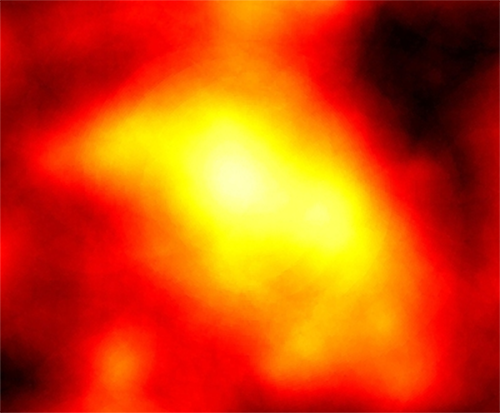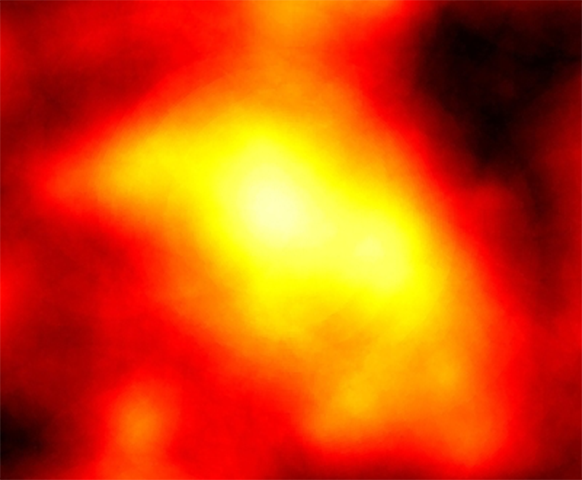Deciphering Gamma Rays from a Dwarf Galaxy
The dwarf galaxies of the Milky Way are quiet backwaters in astrophysical terms, holding only a handful of stars. Yet the orbits of those stars reveal the presence of copious amounts of dark matter, the mystery substance that comprises over 80% of the matter in the Universe. Researchers thus see dwarf galaxies as promising dark matter hunting grounds, in which visible matter provides little disturbance. Now, two independent studies assess the hypothesis that faint gamma rays from a recently discovered dwarf galaxy could potentially be signatures of collisions between dark matter particles. At first glance, the analyses appear to deliver conflicting results. The first, by Alex Geringer-Sameth at Carnegie Mellon University, Pennsylvania, and co-workers [1], suggests that these gamma rays are a possible indication of dark matter, while the second, by Alex Drlica-Wagner at Fermi National Accelerator Laboratory, Illinios, and colleagues [2], indicates they could just be a fluctuation of the galactic gamma-ray background.
Dark matter can be detected through its gravitational effects, but its underlying nature remains one of the great mysteries of modern physics. Proposed dark matter models often predict that colliding dark matter particles could annihilate each other, producing a spray of detectable photons at a range of wavelengths, including gamma rays. Such signals could yield our first clues, other than those coming from gravitational effects, to the nature of dark matter.
These annihilations would be most common where dark matter is very dense. Dark matter, like ordinary matter, collects at the centers of galaxies and galaxy clusters. However, there are also smaller dense clumps of dark matter orbiting the center of the Milky Way, which are thought to be residues of our Galaxy's formation. Gas attracted to these clumps can form stars, creating clusters known as dwarf satellite galaxies.
Such galaxies have far more mass than one might expect from the light they emit [3], implying an abundant presence of dark matter. Each galaxy contains only a small number of stars and little other visible matter that could generate light masking dark matter annihilation signals. Recently, astrophysicists identified nine new possible dwarf galaxies [4, 5]. One of these, named “Reticulum II,” is closer to Earth than all but two of the known dwarf galaxies and is thus a promising place to search for the byproducts of dark matter annihilation.
Using data from the Fermi Gamma-Ray Space Telescope (hereafter, Fermi), Geringer-Sameth and colleagues [1] have searched for gamma rays originating from Reticulum II. At the same time, Alex Drlica-Wagner’s group within the Fermi collaboration has independently performed a similar analysis [2]. Both teams find a surplus of photons at similar gamma-ray energies, i.e., a potential gamma-ray "signal," but disagree on whether these photons could merely be a statistical fluctuation of the background.
Few gamma rays are expected from ordinary matter within Reticulum II. But the hazy veil of stars and interstellar gas between the Earth and Reticulum II could release gamma rays appearing to originate from the dwarf galaxy. To separate the two contributions, Geringer-Sameth et al. weighted every detected photon with the probability that it originated from Reticulum II versus this background. After this separation, they claim to have found evidence for a significant flux of gamma rays from Reticulum II (see Fig. 1). Interestingly, the energy range of these photons, 2–10 giga-electron-volts (GeV), is consistent with a signal from the Galactic Center observed in 2009, which was also interpreted as a possible signature of dark matter annihilation [6]. That signal remains controversial because of the large gamma-ray backgrounds from conventional matter in the Galactic Center, but the detection of a matching signal in dwarf galaxies, if confirmed, would greatly strengthen the case for dark matter.
Drlica-Wagner et al. [2] have also found an indication for extra gamma rays associated with Reticulum II. However, they argue that this “signal” was consistent with a statistical fluctuation of the background and did not provide significant evidence for a source associated with the dwarf galaxy.
So where does the difference arise? First of all, the data employed by the two groups were not identical. Geringer-Sameth et al. worked with data publicly released by Fermi, while Drlica-Wagner et al. used data exclusive to the Fermi Collaboration. As a consequence, the numbers of photons used in the two analyses are somewhat different, which affects the statistical significance of the signals. Geringer-Sameth et al. found that the chance of a background fluctuation mimicking the potential dark matter signal is ∼0.3%. This is, by convention, the threshold for calling the detection “significant evidence.” Drlica-Wagner, on the other hand, found a probability of 1% [7]—meaning that the signal is more readily explainable as a statistical fluke. In both cases, these numbers aren’t yet small enough to be definitive evidence for a signal. However, a third unpublished study by Dan Hooper and Tim Linden [8], appearing later, found an even smaller probability (0.16%), supporting Geringer-Sameth’s interpretation. This analysis used the same public data as Geringer-Sameth et al. and assumed a dark matter model matching the possible signal in the Galactic Center [5].
Second, whether background fluctuations or dark matter can explain the data, depends on the dark matter models tested. The numbers quoted above are based on an analysis using the “best” dark matter model—defined as the one that most closely matches the data. A more conservative analysis would be model independent and take into account, for instance, that a dark matter annihilation signal could have appeared at a different energy. Once this possibility is included, the odds of a background fluctuation, comparable to what is seen, rise to ∼1% and to ∼6% for the analyses of Geringer-Sameth and Drlica-Wagner, respectively. These numbers place the signal in the category of an interesting hint but not solid evidence.
The last major difference between the two studies concerns their treatment of the other newly discovered dwarf galaxies. While Geringer-Sameth et al. focused solely on Reticulum II, Drlica-Wagner et al. also studied seven other dwarf galaxy candidates, in which they found no equivalent signal. Under the assumption that each dwarf galaxy had an equal chance of producing an observable dark matter signal, they concluded that the “signal” in Reticulum II was consistent with a statistical fluke.
However, this conclusion may be overly pessimistic: It does not take into account that one would expect to detect a dark matter signal from Reticulum II before seeing one from the other dwarfs, simply because it is closer to Earth. Furthermore, Reticulum II may contain more dark matter than other dwarf galaxies. This latter question is challenging to address—astronomers estimate the dark matter content of dwarf galaxies from the orbits of a small number of stars, and the resulting dark matter annihilation signal can be uncertain by up to an order of magnitude [9]. More precise measurements of the dark matter content of the dwarf galaxies will thus be crucial to assess the current hints.
What’s next? Improved modeling of gamma-ray sources in the surrounding region could help researchers assess the contribution of the gamma-ray background. Furthermore, ground-based gamma-ray telescopes can study the dwarf galaxies at higher energies than Fermi. According to some dark matter models, a counterpart signal could be found in this spectral region. But the best hope for rapid progress may be the discovery of more dwarf galaxies by the Dark Energy Survey and other experiments. The presence (or absence) of a similar signal from multiple dwarf galaxies would greatly strengthen (or weaken) the dark matter interpretation.
The gamma-ray signal from Reticulum II may turn out to be simply a background fluctuation, but it is too soon to discard the hypothesis that it might indicate something very exciting.
This research is published in Physical Review Letters and The Astrophysical Journal Letters.
References
- A. Geringer-Sameth, M. G. Walker, S. M. Koushiappas, S. E. Koposov, V. Belokurov, G. Torrealba, and N W. Evans, “Indication of Gamma-ray Emission from the Newly Discovered Dwarf Galaxy Reticulum II,” Phys. Rev. Lett. 115, 081101 (2015).
- A. Drlica-Wagner et al. (Fermi-LAT Collaboration, DES Collaboration), “Search for Gamma-Ray Emission from DES Dwarf Spheroidal Galaxy Candidates with Fermi-LAT Data,” Astrophys. J. 809, L4 (2015).
- M. Walker, “Dark Matter in the Galactic Dwarf Spheroidal Satellites,” in Planets, Stars and Stellar Systems: Vol. 5, Galactic Structures and Stellar Populations, edited by Terry D. Oswalt and G. Gilmore (Springer, Dordrecht, 2013), p. 1039[Amazon][WorldCat].
- K. Bechtol et al. (DES Collaboration), “Eight New Milky Way Companions Discovered in First-Year Dark Energy Survey Data,” Astrophys. J. 807, 50 (2015).
- S. E. Koposov, V. Belokurov, G.Torrealba, and N. W. Evans, “Beasts of the Southern Wild: Discovery of Nine Ultra Faint Satellites in the Vicinity of the Magellanic Clouds,” Astrophys. J. 805, 130 (2015).
- L. Goodenough and D. Hooper, “Dark Matter Annihilation in the Galactic Center as Seen by the Fermi Gamma Ray Space Telescope,” Phys. Lett. B 697, 412 (2011).
- Talk presented by Keith Bechtol at CIPANP 2015, 22 May 2015 (http://indico.wlab.yale.edu/indico/event/2/session/5/contribution/285).
- D. Hooper and T. Linden, “On The Gamma-Ray Emission from Reticulum II and Other Dwarf Galaxies,” arXiv:1503.06209.
- J. D. Simon et al. (DES Collaboration), “Stellar Kinematics and Metallicities in the Ultra-Faint Dwarf Galaxy Reticulum II,” Astrophys. J. 808, 95 (2015); V. Bonnivard et al., “Dark matter annihilation and decay profiles for the Reticulum II dwarf spheroidal galaxy,” Astrophys. J. 808, L36 (2015).





